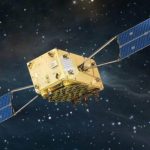Q: How will the Open Service Galileo signal in space change the acquisition process in GNSS receivers?
A: The Galileo signal in space (SiS) for the Open Service (OS) essentially differs from the GPS C/A-code by its use of the binary offset carrier (BOC) modulation and the adoption of longer spreading codes. Moreover, two different channels have been allocated for the OS: the data and the pilot channels. The former carries the navigation message whereas the latter is data-free.
Q: How will the Open Service Galileo signal in space change the acquisition process in GNSS receivers?
A: The Galileo signal in space (SiS) for the Open Service (OS) essentially differs from the GPS C/A-code by its use of the binary offset carrier (BOC) modulation and the adoption of longer spreading codes. Moreover, two different channels have been allocated for the OS: the data and the pilot channels. The former carries the navigation message whereas the latter is data-free.
The pilot channel is characterized by a secondary code that modulates the primary spreading sequence, producing a tiered code with a period of 100 milliseconds. The bit-rate of the data channel is 250 sps (symbols per second) against the 50 sps of the GPS C/A-code. A GNSS receiver can perform acquisition of the pilot and data channels separately, and the results of the two processes can be non-coherently combined in order to exploit the fact that the two signals experience the same code delay and Doppler frequency.
The first stage of a GNSS receiver consists of an acquisition block, which provides a rough estimation of the code delay and of the Doppler frequency of the received GNSS signals. These two quantities are obtained by correlating the received signal with several locally generated signal replicas, characterized by a specific code delay and Doppler frequency. Due to the spreading codes’ properties, the correlation between the received and the locally generated signals assumes a significant value only if the delay and the Doppler frequency of the local replica match those of the received signal.
The acquisition process searches for all possible delays and Doppler frequencies until the correlation passes a threshold. When that happens, the GNSS signal is considered to have been acquired, and the delay and Doppler frequency of the local replica are the estimates of the corresponding parameters of the received GNSS signal.
Acquisition performances are essentially measured by the searching time and the acquisition sensitivity. The former is the mean time needed to detect the GNSS signal and to estimate its parameters; the latter is directly related to the C/N0 (carrier-to-noise density ratio) of the weakest signal the receiver can acquire.
Various factors can impair signal acquisition. These may be related either to the GNSS signal structure, such as the presence of bit transitions in the navigation message, or to external causes such as interference, signal fading, and shadowing.
(For the rest of Daniele Borio and Letizia Lo Presti’s answer to this question, please download the complete article using the PDF link.)
Q: What are the main factors affecting the acquisition of weak GNSS signals? What can be done to alleviate them?
A: The acquisition of weak GNSS signals is not a trivial task. Many effects that can be safely ignored when acquiring strong signals become significant as receiver sensitivity increases.
In brief, acquisition is a two-dimensional search process. The receiver knows that, if a given satellite signal is being received, then the code phase and Doppler frequency of that signal must be within certain known ranges.
These two ranges of values define a two-dimensional uncertainty region. This uncertainty region is divided into a finite number of search cells, each of which represents a single code phase and Doppler frequency estimate pair.
During acquisition the receiver observes the received signal for a certain period of time in each cell, say TObs, subsequently making a decision as to whether or not a signal from a particular satellite is present in a given cell. The sensitivity of the receiver is critically dependent on TObs as a longer observation time permits the detection of weaker signals.
This requirement to observe the signal for longer periods is the cause of most of the difficulty with weak signal acquisition, as we will discuss in the next section.
(For the rest of Dr. Cillian O’Driscoll’s answer to this question, please download the complete article using the PDF link.)





